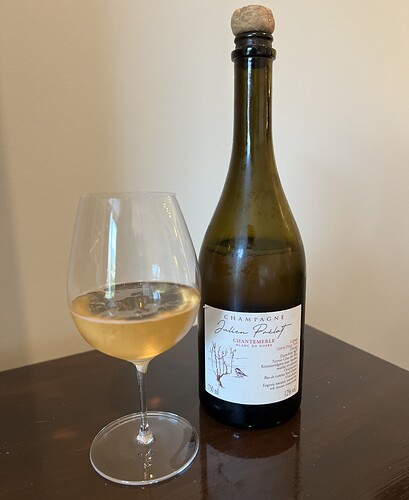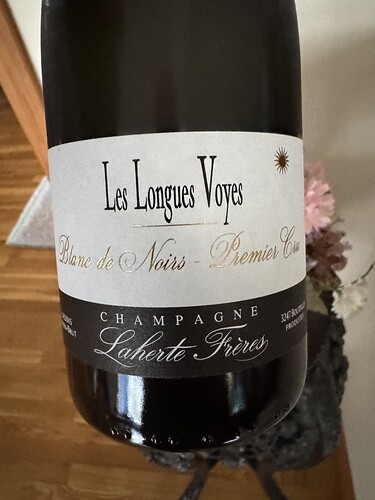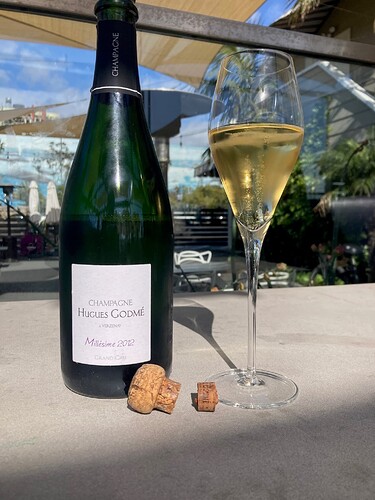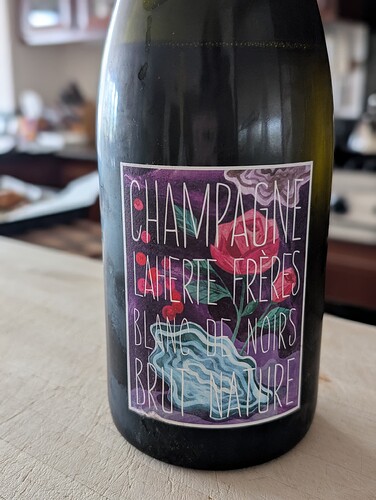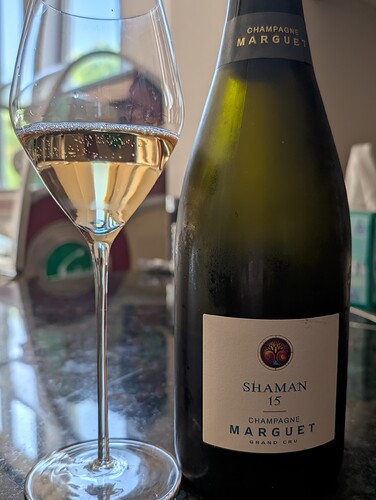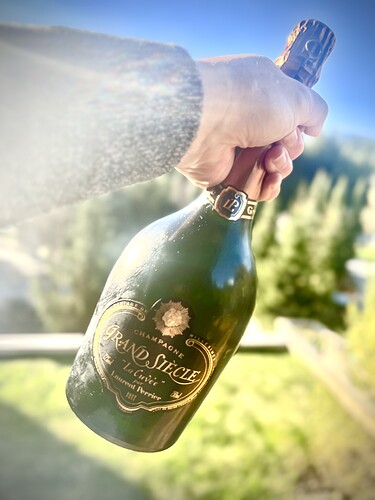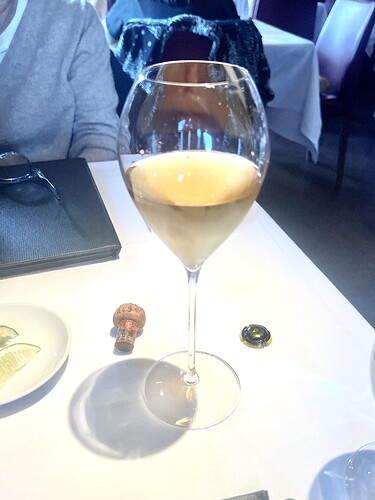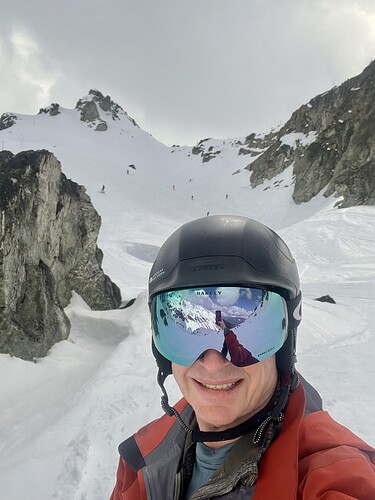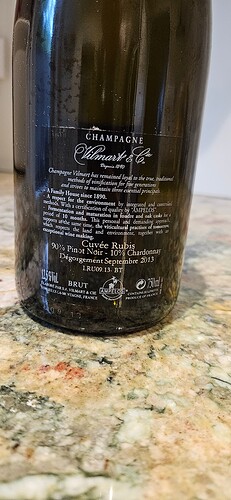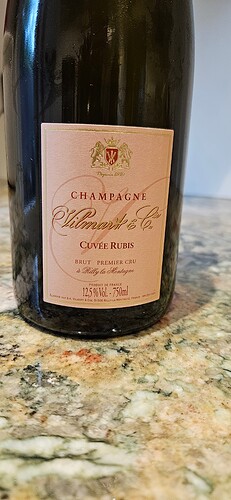very tasty and well balanced with a gorgeous hay color - oodles of brioche and ample orange-type citrus
Been away from my cellar and this forum for too long. Since returning the remarkable champanges I have had are Roederer 2012, I had forgotten how good it is, and Taittinger CdC 2006 which is still as good as I remembered. No surprises or new insights, but it is good to be back. Thanks for all your posts!
Opened this following the Aurelian Laherte Zoom. It’s amazing! Laura asked if we had more after she took one sip!
Cross-posted:
NV Laherte Frères Champagne Blanc de Noirs Brut Nature
50%PM from Chavot & Moussy, 50% PN from Breuil. 0 dosage. Full malo. Disg May 2023.
I opened the LF the evening before the Zoom since I didn’t want to drink at 9:30AM…
Rough mousse - honestly was surprised at how rough it was, but everything went upwards from there. Red apple, ripe apricot, juicy ripe lemon. Great acidity, but the fruit is perfectly in balance. The 0 dosage is not screaming at you ![]()
Another less recent bottle:
NV Marguet Champagne Grand Cru Shaman 15
67% PN 33% Chard. Disg May 2019. dosage 0g/L
Juicy citrus, yellow berry, saline in the mid palate, and a hint of creaminess from the gentle butterfly-kiss of oak. Delicious. It reminded me that I used to enjoy Marguet. Honestly, this bottle made me really sad because it is such a contrast to more recent Marguet bottlings where the oak wallops the nose from a foot away or it’s starting to go “lambic-esque”. I’m really hoping for a return to more modest oak and some sulfites for the currently unsulfured bottlings, but having been burned a few too many times, I won’t be purchasing new bottlings to find out.
Perfectly said. Alas.
Newer label on that Laherte bottling, haven’t seen that one yet.
-Al
New LF label is sick!
Same song we all seem to be singing re: Marguet.
I wondered if that was a typo, but then I clicked through to the pics!
So does champers pair well with crickets?
what the hell, opened 08 Dom last night. Wide open, full throttle, gorgeous fruit, stunning wine. Not sure if at the level of 96, but a real wow wine.
Good discussion here post-LF Zoom. I too like the BdN label, for that part of the range. Funny, on my agenda was to be some dedicated time to cover how/why he differentiates his range but time is always the greatest thing to manage in these events.
I believe (and I will go ask Aufrelien to confirm) that the colored labels, like the BdB and BdN no dose bottles, the Petit Meslier, etc…those all have reserves in them and/or, like we discussed with the Craie bottling, or he doesn’t vintage designate a wine. In sum, the colored stuff is multi-vintage or non-vintage designated by choice, and in contrast, the white labeled bottles, like the Autrefois, Rouges Maison, etc, are all vintage and single plot. I’m pretty sure this is the answer for the how/why.
Of note, I thought Aurelien’s characterization of why/how he makes the Nature de Craie was one of the cool parts of the discussion for me. He doesn’t vintage designate it (even though he could), and he doesn’t make obvious the sans soufre or no no dose properties to that wine. He simply wants the person who drinks it to first think, this is Chardonnay, in a pure form…it is is about the grape first, and then it can be about the vintage and or village (Vertus/Voipreux) if you want that extra context.
I’ve had all kinds of critters. These ones weren’t very good. I think they were made as novelties more so than actual snacks.
So the pairing was very average ![]() .
.
Last night, we brought another old Laurent-Perrier Grand Siècle La Cuvée from my cellar to Araxi to accompany an excellent dinner. Marybeth wasn’t drinking, so I shared it with our server and sommelier, and left some for the kitchen.
The cork code was A49, indicating disgorgement in the first quarter of 1994. Given the typical 10–12 years on the lees, my best guess is that this was Grand Siècle Iteration 12 (1982 | 1979 | 1976, 57% Chardonnay and 43% Pinot Noir). It’s also possible it was Iteration 13 (1985 | 1982 | 1979, same blend).
Regardless of the specifics, it was a stunning bottle. Dense, luscious, and complex, with notes of quince jelly, coffee, mushrooms, and dried fruit, touched by a faint whiff of sherry. Despite the old-sounding descriptors, the wine still showed real freshness and energy. Granted, I’ve been fairly accused of liking Champagne with more age than most, but I think any wine lover would have swooned over this one.
For those of you who enjoy thinking about and comparing vintages, here is a 9 min video that is excerpted from this past weekend from our Laherte Freres Zoom with Aurelien Laherte. He walks us through each vintage–weather, challenges, results. It’s a great tool for appreciating things like grape maturity, work in the vineyard and how to confront tough vintages.
Frank,
I think the easiest way to look at the Laherte range is that the colored labels are more focused on a style expression than a site or terroir expression. For example, Empreintes is vintaged and is part of the colored label range, but is more about the style of a year than anything else. The more traditional label design is focused on the wines that are meant to speak more of a specific site/place/terroir; most are vintaged as you note, but not all. Of course, all of this ignores the fact that Ultradition can still be found in the old style label for the Brut releases and the BdB.
That’s a god summation, Brad. The distinctions are helpful. Earlier I sent the questions to Aurelien and if he follows back, I will post it, too.
Cross-posted:
Losing a bit of fizz but still very delicious with some strong strawberry fruit. Dark wild salmon pinkish red.h
Brodie, yah man, that is an older disgorgement. Good work on putting that aside for some age.
